Part of the Using Newspapers to Track Dates and Locations series.
At the start of the new year, 1976, a curious series of advertisements appeared in the pages of Athens’ weekly broadsheet, the Athens Observer. At times, the ads seemed to constitute a sort of art project rather than a marketing campaign. They certainly distinguished the new business they were promoting, a coffee house that would feature live music, mostly acoustic (jazz, folk, classical), and screen the kind of movies not regularly seen in the college town of less than 50,000 residents. The new business was called the Chameleon, reflecting the eclectic options it aimed to offer.
If you have read any of the numerous articles and books about the Athens music scene’s emergence in the years, 1977-1979, you have undoubtedly come across references to and reminiscences of Tyrone’s O.C., the nightclub that opened in January, 1979, and tragically was struck by a fire in January, 1982, destroying the building where it was located (110 Foundry Street). Pylon, R.E.M., and several other bands that developed in the wake of the international success of the B-52’s all played at Tyrone’s. These bands refined a danceable style of “new wave” rock that would make the college town of Athens an unlikely pop-music mecca for decades to come. Tyrone’s was located in the same building as the aforementioned coffee house/ nightclub/ cinema. Indeed, the “O.C.” in the venue’s peculiar name stood for Old Chameleon.
The first of the Chameleon’s pre-opening ads, seen below, ran in the January 8th Observer, taking the form a letter to the local community. Clearly, the founders of this new establishment wanted to build up anticipation among those eager for new options when choosing where to eat and drink or what to do for an evening’s entertainment.
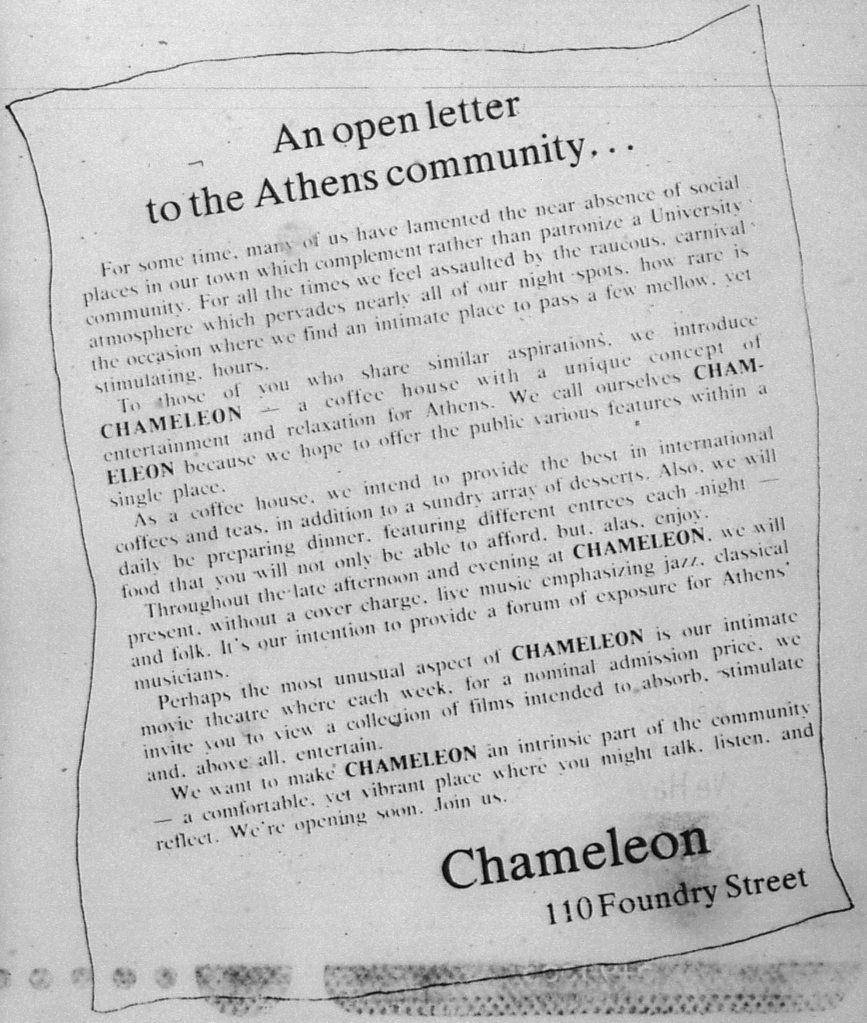
The second ad, from January 15th, promises a wide range of experiences that the Chameleon’s clientele would be able to enjoy if they would only sample the new establishment’s diverse wares.
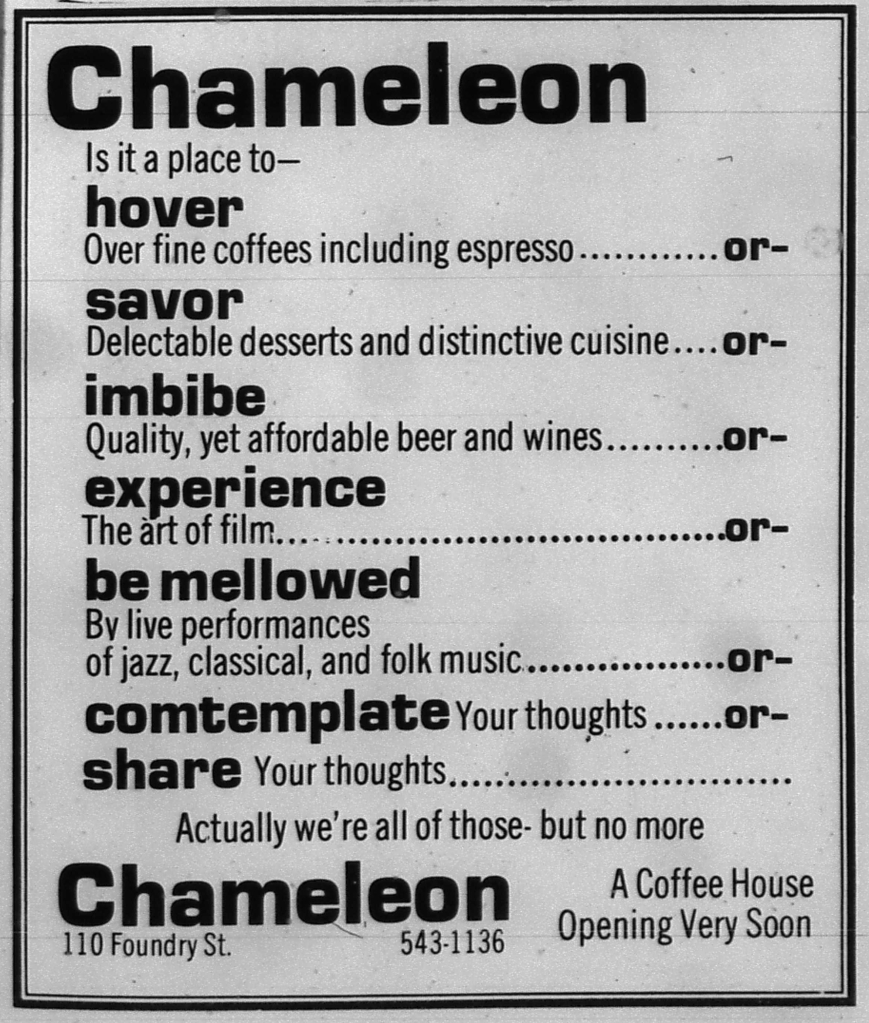
Two weeks later, January 29th, the third ad in the series continued the promises and offers a charming hand-drawn map of a major intersection in what was then downtown’s “warehouse district.” The building labeled for some unknown reason, presumably comical, “Jazz Dog Food,” whatever it is no longer exists, having made way for the News Building (being imprecise, the drawing could refer to the Swift Building, 599 East Broad Street, or the location of Christian Hardware, 597 East Broad Street). Thankfully, the structures that housed the Potter’s House (112 Foundry Street, later home to Flagpole) and Farmers Hardware (582 East Broad Street) still stand. The ad for the J & J Center is included to give readers a taste of the kind of competition the Chameleon would face during these quieter times for Athens nightlife.
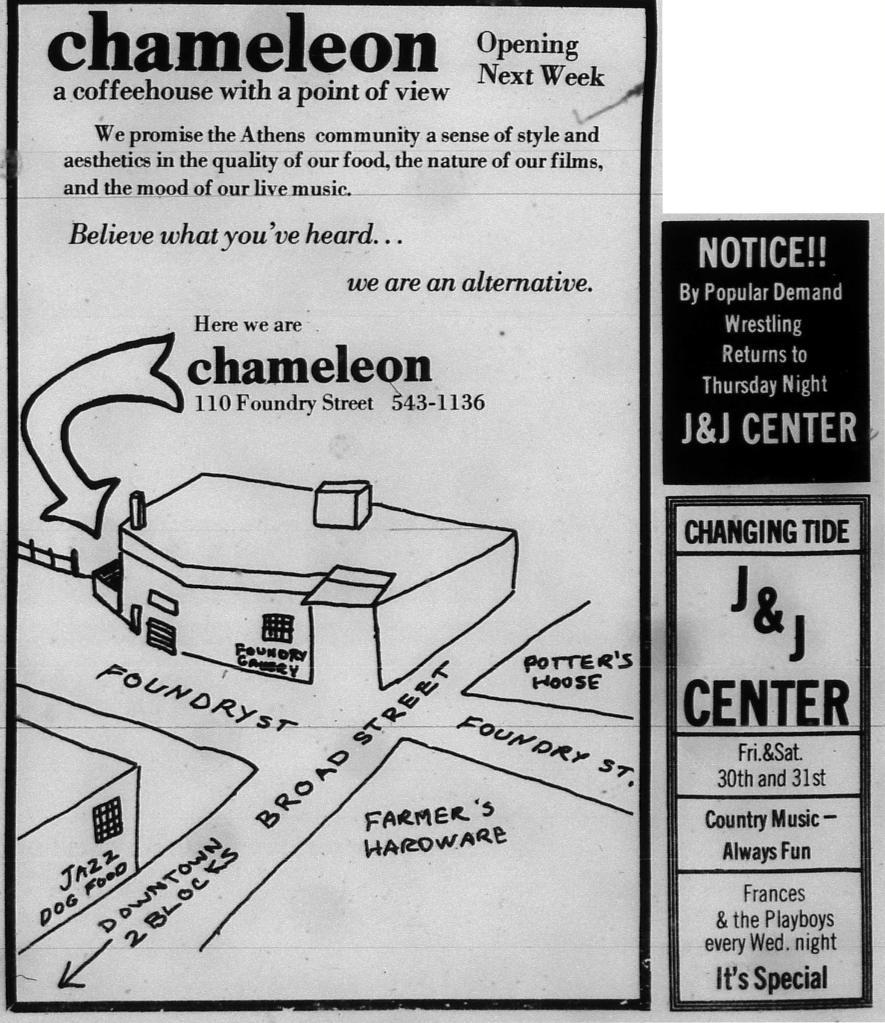
In the February 5th Observer, the final advertisement to run before the Chameleon’s opening took the new businesses’ marketing ambitions to a new extreme.

No-one at this point would deny that the Chameleon had a “point of view.”

That said, a music venue that, when it first opened was very similar to what the Chameleon was now striving to do, the Last Resort, ran its own letter-to-the- community-as-advertisement in the February 12th Observer announcing its February 23 reopening after a brief closure (the date given for its founding, 1965, as far as I know, is inaccurate; it apparently opened in 1967). As noted in the articles here on the Last Resort and the 40 Watt Club, the Last Resort would close and reopen yet again in 1979. The earlier reopening seems to be when the business expanded to occupy two storefronts, while the later brought a renovation of the facility, enhancing its live-sound capabilities as more rock acts played the venue.

Almost like clockwork, as the Last Resort expanded and moved away from its folk and jazz roots, the Chameleon came along to take its place. The article seen above, from the February 6th, 1976, edition of the Red and Black, describes the scene.

The ad shown above, from the February 12th Observer, finally offered some details about the new business. That “no cover” part was very important. Note too that the movies were shown in a separate room within the venue.

The diligent Lila Moore at the Red and Black followed up her preview of the club with a review, copied above, published in the February 18th edition.

This ad, from the February 17th Red and Black, shows a bold movie selection: the Japanese classic Woman in the Dunes. Also showing were two Alfred Hitchcock films and the animated short adaptation of James Thurber’s A Unicorn in the Garden, leaving few to doubt that the Chameleon’s promise of “a collection of films intended to absorb, stimulate, and, above all, entertain” had been fulfilled.

The February 12th Observer‘s community calendar is provided here in full for the reader to see how the Chameleon stacked up next to other Athens communal gatherings. One of the venue’s regular music acts, the Bill Mizelle Quartet, is listed. Athens’ live-music options at this point seem scant indeed, especially if one were to compare them to the same listings only four or five years later. In Atlanta, on the other hand, in the course of a single month, one could witness Little Richard, Bob Seger, Dave Brubeck, Jimmy Buffett, Waylon Jennings, the O’Jays, Roger Williams, David Bowie, and Carole King, not a single one of these concerts costing even 10 dollars.
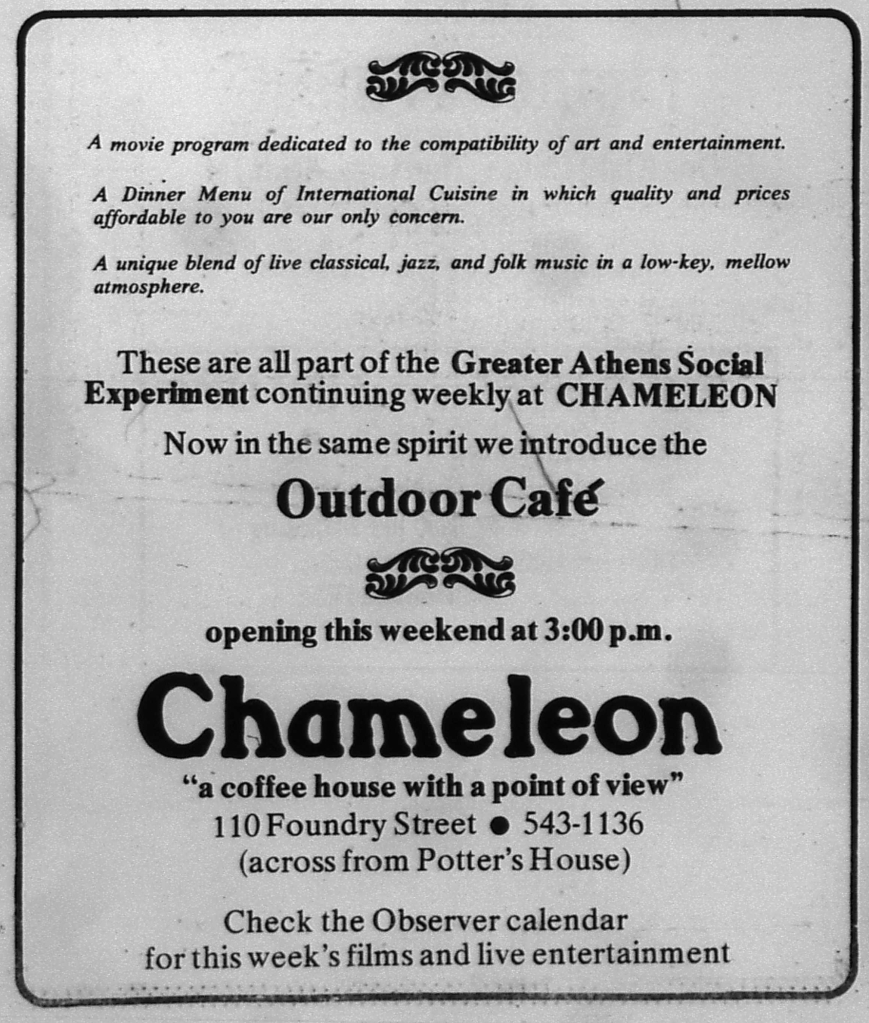
In an ad from the March 25th Athens Observer, the Chameleon is now a “social experiment” and is pleased to announce the introduction of outdoor seating for its diners.

An advertisement for a local painter, Chatham McCommons, in the March 11th Observer, serves as an unlikely source of a photograph (sadly showing up very poorly in this microfilmed version) of the Chameleon’s outside sign and, we assume, some of the coffee house’s proprietors.
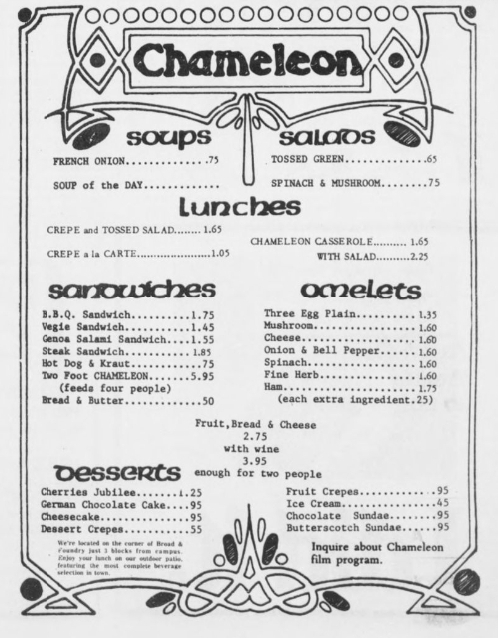
The ad above, from the March 29th Red and Black, lets us know what one could eat at the Chameleon.

Nightclubs and bars offering a full lunch and (sometimes) dinner menu were not so rare in Athens circa 1976. The ad above, for the B & L Warehouse from the March 11th Observer, and that below, for T.K. Harty’s from the January 22nd Observer, provide copious examples of what these kinds of businesses were cooking up for their customers. All of them served a decent selection of meals, perhaps a regional variation when compared to the sandwiches found at prototypical Midwestern dive bars.

A sense of where these three eating options fit into Athens’ overall restaurant scene is provided by the Red and Black article displayed below, from the August 5th issue. Here you’ll find brief descriptions of long-gone local favorites like Pizza Inn, the Spaghetti Store, Manuel’s, the A & A Bakery, Sons of Italy, Poss’ Barbecue, and El Dorado, as well as one restaurant still going strong: the Mayflower. (As always, to read the text better, right-click the image and open it in a new tab at its full size.) A retrospective 2018 article from the Red and Black discusses the history of a couple of these restaurants.

Notice too the ads for Georgetown News and Tobacco and Normal News and Tobacco (the latter of which lasted until the early years of this century) selling High Times, Mother Earth News, and, appropriately enough, “head supplies.”

Another Red and Black article, from September 23rd, 1977, reviewing jazz music in Athens, Atlanta, and statewide, takes us nearly two years into the Chameleon’s run, with Bill Mizelle’s group still playing. As suggested by this article and advertisements for local nightclubs and restaurants like Speakeasy, Sparky’s, and Prime Time, the Chameleon had some local competition when it came to offering live jazz music.

An article a few days later (September 26th) details the nightclub scene for new students and other Red and Black readers. The Other Place (in the same location as the Mad Hatter a few years down the line), the Hedges (behind Allen’s, where Foxyz Tavern later became a reliable favorite), and the B & L offered plenty of live rock music; the J & J offered country music—not the highest-selling nationally-known performers, but rather lesser-known regional favorites and rising stars; while several other spots offered fare geared more toward older crowds.
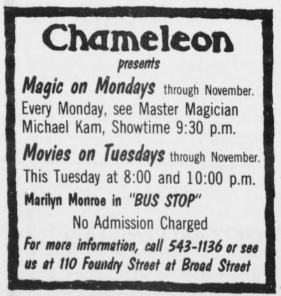
A Chameleon ad from the November 14th, 1977, Red and Black suggests that the coffee house was amending its high-brow preferences to draw more crowds, with a magician appearing regularly and a Marilyn Monroe movie on the schedule. Similarly, an ad from February 24th, 1978, promotes the establishment’s two-year anniversary special: one-cent beer with the purchase of lunch.

Nonetheless, in an ad from the April 13th, 1978, Red and Black, the club still promotes its live jazz offerings. After this, the Chameleon’s advertisements disappear from the Red and Black, though there is a reference to the club in the paper’s classified ads as late as November.
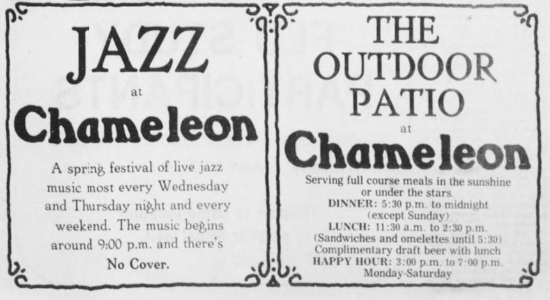
Turning back to the Observer, we learn that, as of January, 1979, the Chameleon had closed for renovations; and, in the January 11th issue, that the club would take on a new name and reopen on January 18th. Sure enough, an advertisement announcing the new club appeared in next week’s issue. The continued presence of jazz music is made evident by the illustration and the club’s inaugural artists: local act the Night Bloomin’ Jazzmen.

In the same issue, the Observer‘s reporter and humor columnist, Athens legend Phil Sanderlin, covered the changeover from the Chameleon to Tyrone’s, as well as the reopening of the Last Resort and the opening of two new nightlife spots, Speakeasy and Crazy Zack’s.


Tyrone’s first makes an appearance in the Red and Black “After Hours” listings in April, 1979. According to an overview of local nightclub offerings, written by Red and Black‘s Bobby Byrd for its September 19th, 1979, issue, Tyrone’s offerings tended toward folk and jazz, similar to the Chameleon and the early days of the Last Resort. The concert listings prove this; the venue featured jazz saxophonist Sam Rivers, one of the genre’s most innovative artists of the 1970s, that very April. Another early ad from the Observer published on January 25th shows the new venue emphasizing its connection to its predecessor (as a “chameleon of another color”) and an appearance from local jazz artist, longtime University professor Steve Dancz (his name misspelled), who in those days played regularly at multiple spaces around town.
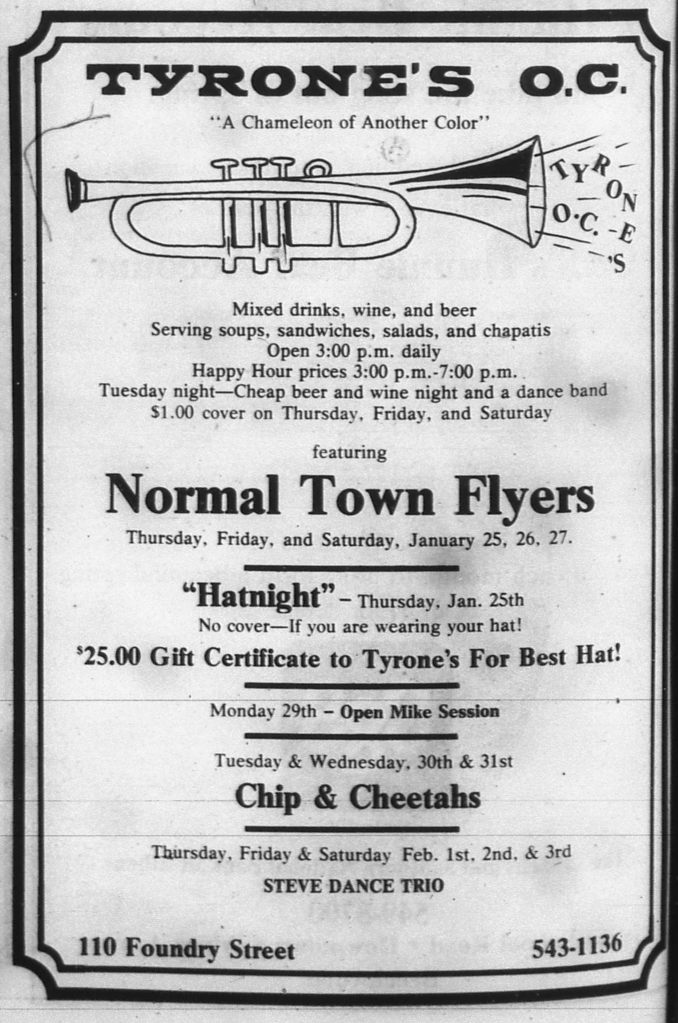
By the end of that first year in business, Tyrone’s began to host Athens’ “new wave” of rock, for example featuring Pylon and the Method Actors for a Halloween gig. But as much as the venue became known to posterity for hosting these and similar bands like Love Tractor, Tyrone’s continued to showcase jazz artists, other kinds of local rock (the Normaltown Flyers, Phil and the Blanks, the Little Tigers, the Michael Guthrie Band… the list goes on), and touring musicians like Townes Van Zandt, the Nighthawks, and Delbert McClinton. In these same years, the Last Resort featured a similar diversity of artists.
Nightclubs featuring jazz, folk, or classical music largely became a thing of the past in Athens, though there would be temporary exceptions, for example the early days of both the Flicker Theatre and Bar and the Winery; and one major exception in recent years, Hendershot’s, which features jazz, classical, and experimental music in addition to performers more commonly found on Athens stages. The Chameleon may largely live on in our memories because of its connection to Tyrone’s (the “Tyrone’s OC” sign still hangs in the 40 Watt Club today) but it deserves mention in any history of the Athens music scene as one of the several baby steps taken on the sleepy college town’s path toward global renown.
—Justin J. Kau

